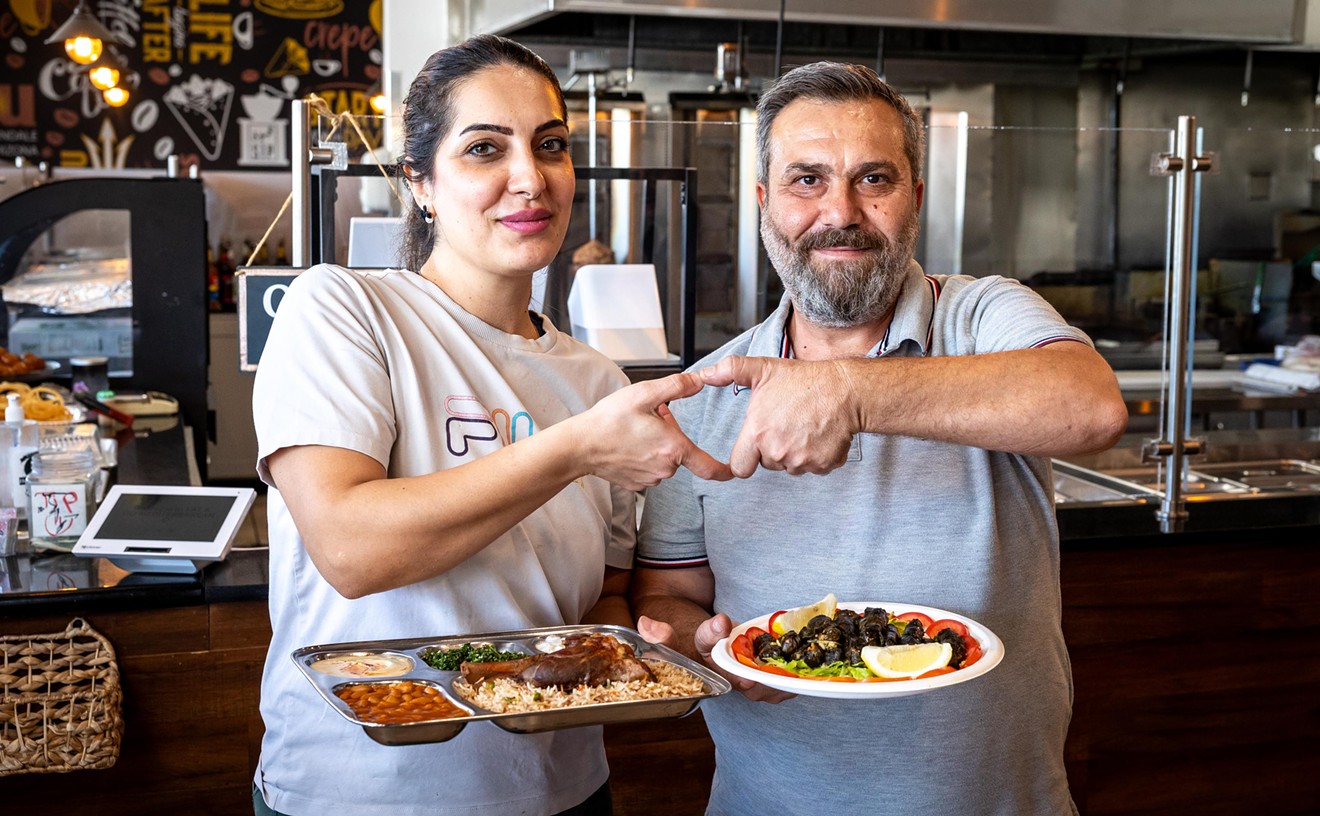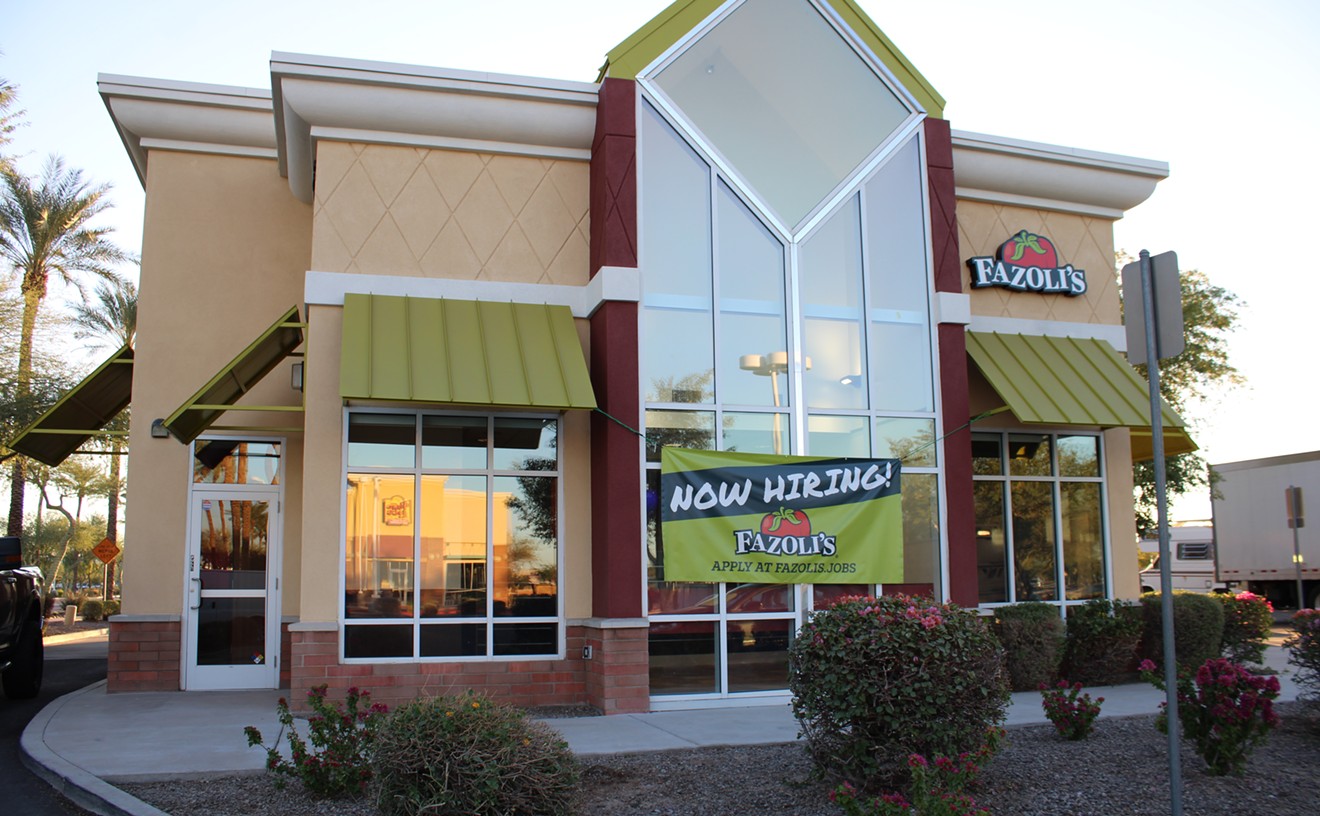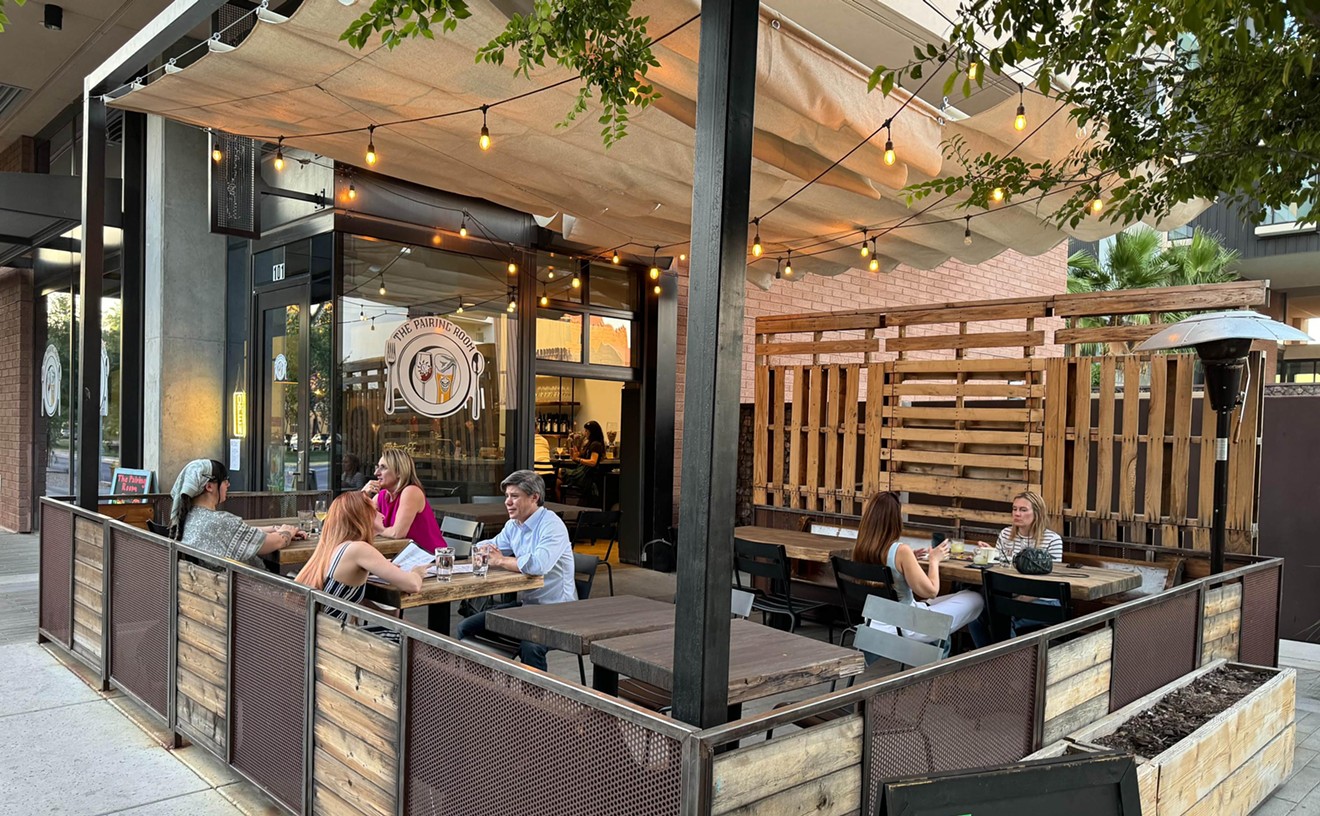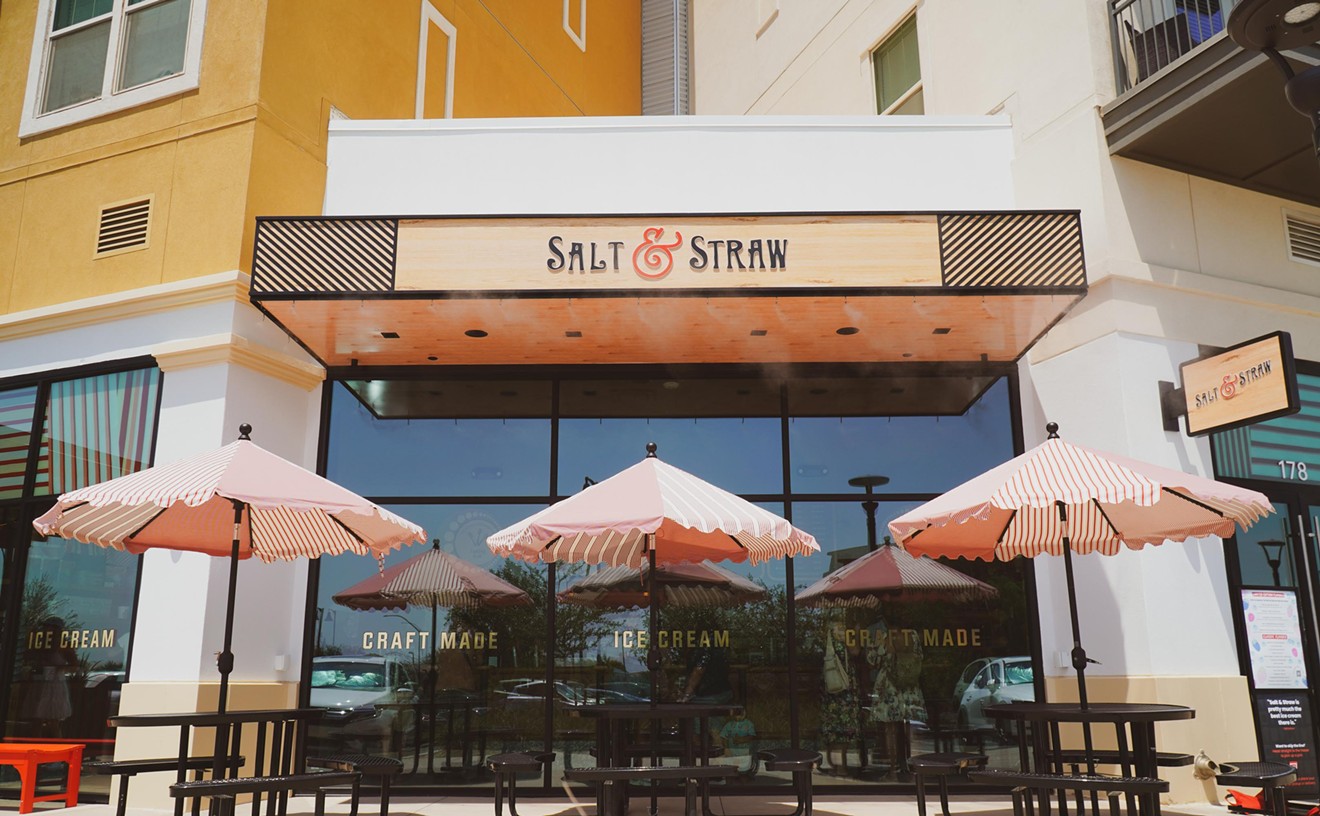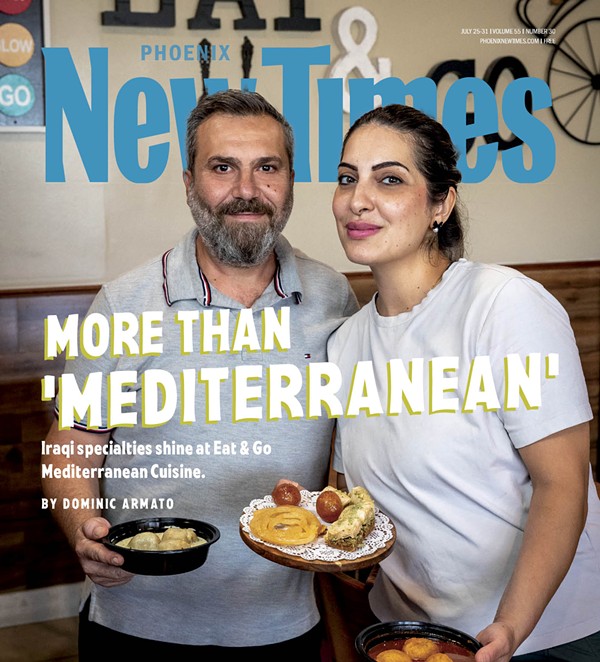Last year, Derek Christensen was a chef of two worlds.
Mostly, he and his wife, Cait Christensen, ran a catering company, Moonrise Standard, known for high-end outdoor meals held in Arizona and California. Picture octopus dangling over cook fires, tables in the dust under a low sun. Occasionally, they’d pop up at a place like Bulthaup Lab in downtown Scottsdale or Wren House Brewing Company.
And a few days a month, they'd drive to Mexico to cook in shelters along the border.
Today, both operations, catering and the nonprofit, are largely on hold. Derek has landed at Arcadia Meat Market. At the celebrated butcher shop, he does everything from imagining new meat-centric victuals to gabbing with customers. On a busy Friday in the butcher shop, we sat down with Derek to talk about his charitable cooking, as well as meat, death, and more.
Phoenix New Times: Last year, you cooked in shelters on the Mexican side of the border wall. What was that like?
Derek Christensen: We were going down to Nogales, Mexicali, Tijuana once or twice a month. We’d bring a ton of food. A lot of it was donated or leftover from Moonrise catering events. So we’d cruise down there, my wife and me. The main shelter we worked with down there was Kino [Kino Border Initiative]. We’d cook food for 200, 300, 400 people at a time.
We cooked simple foods like posole, almost no salt, no spices, nothing too fatty. Some people had been homeless in Nogales for a while. Other people had just traveled a thousand miles on foot. It was so funny to cook, you know, extravagant, five-, six-, seven-course meals here, then cook there. Honestly, it was the same amount of pressure. It was like, oh shit, you gotta be ready when those doors would open. We were still extremely naïve. I still am. I think that’s human nature of the optimist. But we wanted to share a little bit of hospitality and convey the idea that not everybody in the States doesn’t want you to be here.
Are you still cooking in Mexico, or has the pandemic halted that?
DC: Kino has an office just north of the border, and we still give toiletries and a ton of Gatorade powder. We’ll run that down once a month, 50 or 60 or 70 pounds. That’s the extent of it now, and that’s where it’s going to stay for the foreseeable future.
In December, you started at Arcadia Meat Market. How did that happen?
DC: For the holiday season two years ago, my wife and I were doing like four Moonrise events a week, of anywhere between 40 and 100 people. We worked on Christmas Day and Christmas Eve. Coming into the 2019 holiday, we thought it’s not worth it. So I called Nick [Addante, co-owner and frontman of Arcadia Meat Market].
We’ve known each other for three or four years. He sold me beef when I was running Tinderbox Kitchen in Flagstaff. He was working for Arizona Grass Raised Beef then, a kind of a parent company of Arcadia Meat Market now.
What’s your current role at Arcadia Meat Market?
DC: Technically, it’s generally manager. But we call it "vague manager." Occasionally, "asshole." Anything from social media to emails, ordering, inventory, butchering, training people. It’s all over the place. For having kind of a 9-to-5, it’s the only way I can handle being in one place all day.
Do you have a favorite animal to butcher and cook?
DC: I would say lamb. Sheep are wild. I’ve had some crazy experiences slaughtering and butchering sheep up on the reservation, in Navajo country.
The sheep that we pull into the shop are dorper sheep from the Chiricahua Mountains. It’s a crossbreed bred for dry weather. It has less wool, and wool creates lanolin. Lanolin is what gives sheep that intense gamey flavor. So it’s a little more mild. It’s a fantastic meat to cook, especially if you tie that in with a lot of fire, smoke. It’s just delicious.
Two summers ago, you guys sold me a 100-day-aged New York strip steak. Anything weird aging these days?
DC: We broke into a 212-day NY that we straight up forgot about. By the time we saw it, it was like 170, 180 days. We didn’t know what to do with it, so we just hung it up there and at one point we were like, "Let’s just try it." It was funky, to say the least. I can’t even say it was good. It wasn’t bad, but it was as fermented as a meat should be — if not more.
What did the early days of the pandemic look like, when big grocery stores were running out of meat?
DC: It was crazy. We would come in here, and we had 30 people in line when we opened our doors. Every single day. People were buying 50 pounds of ground beef in 1-pound increments. Every day we were learning how to adapt. For a month, we set up outside and were taking orders out front. Some people hated it. They said, "At a butcher shop, I don’t know what I want until I see it" — which is completely fair.
It was peculiar though because we were busier than we had ever been. We didn’t change our principles or our standards or anything. Nothing has changed. We have always been providing people with transparency. We tell you exactly when it was slaughtered, what it ate, what it looks like, who broke it down.
In a butcher shop, you’re surrounded by death. Dead animals. Body parts. Death is a necessary part, a big part, of what you do. Do you ever think about that?
DC: Absolutely. You can’t look anywhere without seeing something that has once lived that is now dead. The closest thing I can equate it to is Dias De Los Muertos. It’s not sad.
What do you mean by that?
DC: We know what we’re doing. All things considered, these animals had a great life. They were humanely raised. They were humanely slaughtered. And they were respected the entire way through. From the ranchers to slaughter to us, there’s so much respect that goes into them.
To us, they’re not a commodity. I think the majority of people come in here because they know, as a consumer of meat, as a consumer of a living thing that died, they shouldn’t be eating a commodity. The more that grows in everybody, the better we’re all off. And that’s the only thing that’s going to create a better system.
[
{
"name": "Air - MediumRectangle - Inline Content - Mobile Display Size",
"component": "18478561",
"insertPoint": "2",
"requiredCountToDisplay": "2",
"watchElement": ".fdn-content-body",
"astAdList": [
{
"adType": "rectangle",
"displayTargets": "mobile"
}
]
},{
"name": "Editor Picks",
"component": "16759093",
"insertPoint": "4",
"requiredCountToDisplay": "1",
"watchElement": ".fdn-content-body",
"astAdList": [
{
"adType": "rectangle",
"displayTargets": "desktop|tablet"
},{
"adType": "rectangle",
"displayTargets": "desktop|tablet|mobile"
}
]
},{
"name": "Inline Links",
"component": "17980324",
"insertPoint": "8th",
"startingPoint": 8,
"requiredCountToDisplay": "7",
"maxInsertions": 25
},{
"name": "Air - MediumRectangle - Combo - Inline Content",
"component": "16759092",
"insertPoint": "8th",
"startingPoint": 8,
"requiredCountToDisplay": "7",
"maxInsertions": 25,
"watchElement": ".fdn-content-body",
"astAdList": [
{
"adType": "rectangle",
"displayTargets": "desktop|tablet"
},{
"adType": "rectangle",
"displayTargets": "desktop|tablet|mobile"
}
]
},{
"name": "Inline Links",
"component": "17980324",
"insertPoint": "8th",
"startingPoint": 12,
"requiredCountToDisplay": "11",
"maxInsertions": 24
},{
"name": "Air - Leaderboard Tower - Combo - Inline Content",
"component": "16759094",
"insertPoint": "8th",
"startingPoint": 12,
"requiredCountToDisplay": "11",
"maxInsertions": 24,
"watchElement": ".fdn-content-body",
"astAdList": [
{
"adType": "leaderboardInlineContent",
"displayTargets": "desktop|tablet"
},{
"adType": "tower",
"displayTargets": "mobile"
}
]
}
]









